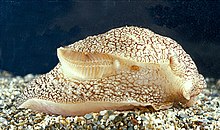
A ctenidium is a respiratory organ or gill which is found in many molluscs. This structure exists in bivalves, cephalopods, Polyplacophorans (chitons), and in aquatic gastropods such as freshwater snails and marine snails.[1] Some aquatic gastropods possess one ctenidium known as monopectinate and others have a pair of ctenidia known as bipectinate.
A ctenidium is shaped like a comb or a feather, with a central part from which many filaments or plate-like structures protrude, lined up in a row. It hangs into the mantle cavity and increases the area available for gas exchange.[2] The word is Latinized but is derived from the Greek ktenidion which means "little comb", being a diminutive of the word kteis meaning comb.
-
Pair of large, grey gills visible inside the mantle cavity of a giant squid
References[edit]
- ^ Ruppert Invertebrate Zoology: A Functional Evolutionary Approach.
- ^ Respiratory system Archived 2020-08-09 at the Wayback Machine The apple snail. Retrieved 2012-04-20.




Well, that’s interesting to know that Psilotum nudum are known as whisk ferns. Psilotum nudum is the commoner species of the two. While the P. flaccidum is a rare species and is found in the tropical islands. Both the species are usually epiphytic in habit and grow upon tree ferns. These species may also be terrestrial and grow in humus or in the crevices of the rocks.
View the detailed Guide of Psilotum nudum: Detailed Study Of Psilotum Nudum (Whisk Fern), Classification, Anatomy, Reproduction